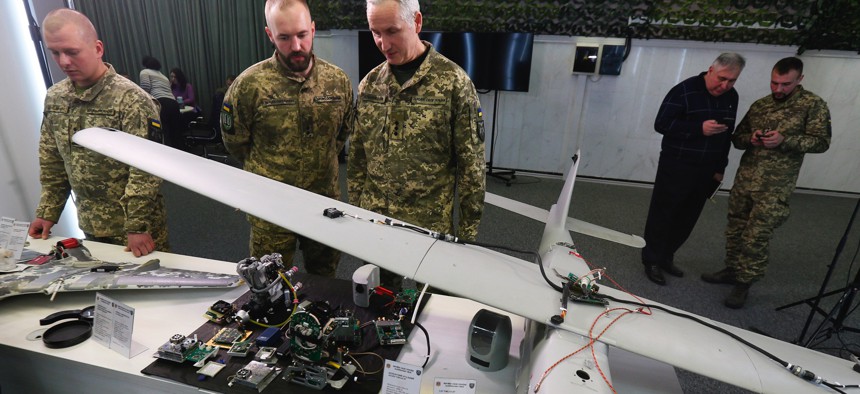
In December, Ukrainian military officials in Kyiv showed reporters parts of various drones used by Russian forces against Ukraine, including the Orlan-10, Granat-3, Shahed-136, and Eleron-3-SV. STR/NurPhoto via Getty Images
US Sending Experimental Anti-Drone Weapons to Ukraine
SAIC is among contenders for a crash Army effort to help the country down Iranian-made drones.
The U.S. is sending anti-drone missiles as part of an experimental platform to help Ukraine down the Iranian-built drones that have devastated its energy infrastructure, according to representatives of government contracting company SAIC.
On Tuesday, the U.S. announced a large package of military aid to Ukraine focused on air defense, including what it called “10 mobile c-UAS laser-guided rocket systems.”
That follows a January competition held by the U.S. Army, which was seeking a system to fight off Shahed-136 suicide drones. SAIC, which participated in the competition, is in the running to send ten of the weapons to Ukraine, a company representative told Defense One on the sidelines of the Association of the U.S. Army’s Global Force Symposium last week.
Russia has used Shahed-136s to attack not just Ukrainian military forces, but also enough civilian infrastructure to cause blackouts across the besieged country. Ukraine has downed many of the Iranian-made drones, which cost about $20,000 apiece, but sometimes is forced to use $500,000 air-defense missiles to do so.
The Army and one other competitor in the test, Invariant Systems, did not confirm that the test was to provide systems to Ukraine, but confirmed other details that support SAIC’s statements.
Contracting documents provided by the Army indicate that the test objective was to destroy Class Three drones—that is, aircraft that weigh more than 55 pounds. The Shahed-136 weighs about 440 pounds.
Other details in the contracting document also conform to information provided by SAIC. For instance, the documents say a winning design should be ready to ship to partner nations within 30 to 90 days of a contract award—roughly the amount of time between the January test and the April news that the systems were being sent to Ukraine.
The contract also says the systems might be funded with Title 22 authorities, which are used to fund security assistance to Ukraine.
In the January test, SAIC used BAE’s APKWS laser-guided rockets, which achieved a 100-percent hit rate, the company representative said.
And at less than $30,000 apiece, the rockets are cheaper than Ukraine’s larger air-defense missiles, said Greg Fortier, the vice president of SAIC’s Army Business Unit.
The system also includes a M240 machine-gun mount and an electronic warfare system that can take control of a commercial drone, including any DJI-brand system not operating with advanced encryption, said Jeremy Davidson, an SAIC systems engineer. DJI drones are frequently used by both sides in Ukraine.
Fortier said their system acquired the drone at over six miles away and struck it at three miles, much farther than the Army’s 1.2-mile requirement.
Fortier said SAIC and Invariant had the best results in the test.
Invariant CEO David Anderson said he had not learned if his system was part of the Defense Department’s announced shipment.
The U.S. has primarily sent existing technology, said Samuel Bendett of the Center for Naval Analysis. It was unclear whether the U.S. had ever sent a weapon that was created from scratch for use specifically in Ukraine.
Other anti-aircraft assistance in the $2.5 billion aid package announced today included munitions for the National Advanced Surface-to-Air Missile Systems, or NASAMS; anti-drone 30mm gun trucks; three air-surveillance radars; and 30mm and 23mm anti-aircraft ammunition. The aid is a mix of equipment drawdowns and procurement, according to a U.S. senior defense official.
The defense official said that the 30mm gun trucks and the laser-guided rocket systems were for shooting down Shahed drones.
“We want to help Ukraine advance and hold this position in what we expect will be a Ukrainian counter offensive,” the official said.
One Ukrainian official indicated that such a counter-offensive would come in spring.
